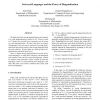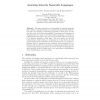278 search results - page 6 / 56 » Strong Separation of Learning Classes |
EUROCOLT
1999
Springer
13 years 11 months ago
1999
Springer
Abstract. Recent works have shown the advantage of using Active Learning methods, such as the Query by Committee (QBC) algorithm, to various learning problems. This class of Algori...
COCO
2003
Springer
14 years 19 days ago
2003
Springer
We define and study strong diagonalization and compare it to weak diagonalization, implicit in [7]. Kozen’s result in [7] shows that virtually every separation can be recast as...
ALT
2006
Springer
14 years 4 months ago
2006
Springer
This paper presents a novel paradigm for learning languages that consists of mapping strings to an appropriate high-dimensional feature space and learning a separating hyperplane i...
GECCO
2006
Springer
13 years 11 months ago
2006
Springer
Genetic Programming offers freedom in the definition of the cost function that is unparalleled among supervised learning algorithms. However, this freedom goes largely unexploited...
JMLR
2006
13 years 7 months ago
2006
We apply a type of generative modelling to the problem of blind source separation in which prior knowledge about the latent source signals, such as time-varying auto-correlation a...


